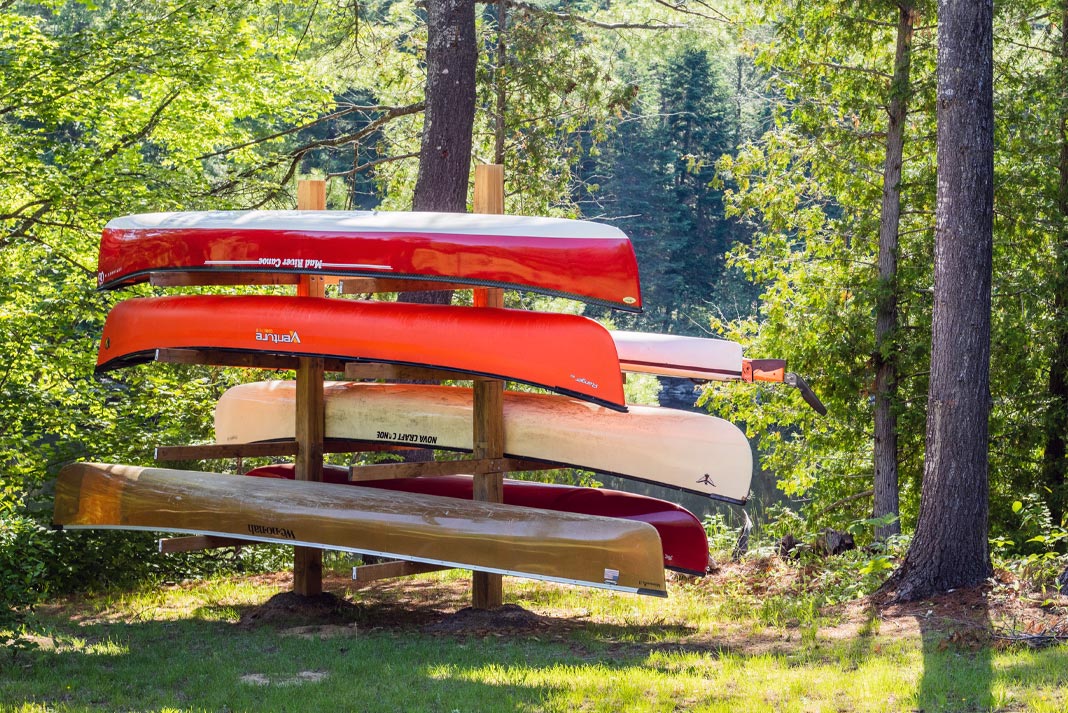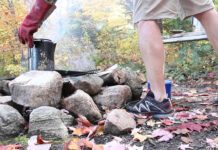At Paddling Magazine, we’re firm believers you can never have too many canoes. Unless, of course, you run out of room for them. So, when we found ourselves short on storage last fall, the Paddling Mag team got to work on one of our favorite paddlecraft storage options.
There are many benefits of proper storage. First, it will prolong the life of your canoe—even the hardiest boat left in the dirt is susceptible to damage from the elements. Special care needs to be taken with wood components in particular, like ash gunwales and cane seats, to keep them off the damp earth, which can cause rot. Keeping an ever-growing collection of canoes contained also keeps the yard looking tidy, making it less likely a family member will wonder why you have so many boats anyways. And, last but certainly not least, lifting boats off the ground tends to mean fewer spiders and earwigs move in.
Building a canoe storage rack is an easy woodworking project you can complete with basic supplies. Spend a little extra to invest in cedar or another weather-resistant lumber.

What You’ll Need
- (2) 10-foot 6x6s for vertical supports
- (8) Eight-foot 2x4s for horizontal supports
- 24 bolts with washers and nuts
- 20 pounds of fast-setting cement
- Saw, chisel, drill, tape measure and level
Step 1: Customize Your Design
How long are your boats? Our office flotilla in need of a winter home ranged in size from a 12-foot Wee Lassie to 19-foot surf ski. We settled on vertical posts eight feet apart, allowing even the shortest boat to overhang a couple of feet on either end. The number of boats in need of storage will help determine the distance between the horizontal support beams the boats will rest on. To maximize storage on our three canoe trees, we opted for eight places per tree, with 24 inches between each support beam. If you have limited space or only a few boats to store, you can amend these instructions to build a one-sided storage rack and affix to a garage wall.
Step 2: Set The Posts
In your chosen spot for the canoe tree, measure the appropriate distance, mark and then dig a hole for each 10-foot post. Dig three feet deep to get below the frost line and prevent your posts from heaving in winter. Put your first post in the hole, level, and then fill with concrete. We didn’t have concrete, but we had limestone dust. We filled the holes slowly, tamping in the limestone along the way. The time you save mixing concrete you spend in tamping, but it’s less messy. Place your second post in the ground and ensure it is level vertically, and also level with the first post by using a straight edge like a 10-foot 2×4, before setting it in concrete too.
Step 3: Build Supports
With both posts solid, it’s time to attach support beams for the first canoe to rest on.Think of them as the limbs of the canoe tree.Start with the lowest support beam 20 inches off the ground. Using a level, measure and mark to center an eight-foot-long 2×4 on the post. Notch out a gap on the post for the 2×4 using a saw and chisel. Drill through the 2×4 and post, then secure the beam using four stove bolts with washers, lock washers and nuts.
Step 4: Measure & Repeat
Repeat the above to construct a matching support on the second post. Ensure this support is level on the post as well as level with the support beam you just fastened on the other post before screwing in place.
Returning to the first post and support beam, we measured 24 inches above for our next support beam, then repeated steps 3 and 4 until all eight support beams were built. If you’re building on flat ground and certain the post holes are dug to a level depth, you could do the work of affixing the support beams to the posts on the ground and then raise, level and cement each post as a final step. This wasn’t an option at our sloped, riverside office. We’re paddlers and writers, not engineers.
Step 5: Get Fancy
Once everything is fixed in place, and if you didn’t use pressure treated lumber, you can keep your canoe tree looking great for years to come by sealing it with a coat of varnish. If you’re worried about scuffing up your canoe’s gunwales, slide some pipe insulation over the support arms of the rack to cradle your babies. And, if you’re concerned about your boat being lifted in the night, you can loop a cable lock or chain around thwart and post to deter would-be thieves. Securing each boat to the rack with a pair of cam straps, ropes or bungees is a good idea anyway to prevent it from becoming airborne in a windstorm.
This article was first published in Paddling Magazine Issue 62. Subscribe to Paddling Magazine’s print and digital editions here , or browse the archives here.
Behold: the family tree. | Photo: Michael Hewis







